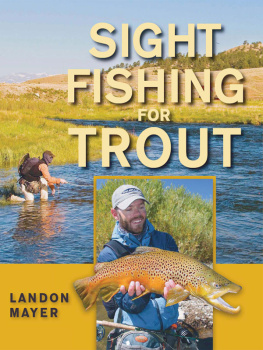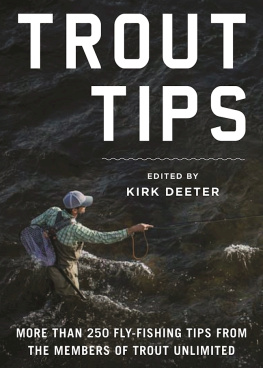TROUT BUM
TROUT BUM
John Gierach


THE PRUETT SERIES
1986, 2013 by John Gierach
ALL RIGHTS RESERVED, including those to reproduce this book, or parts thereof, in any form, without permission in writing from the publisher.
Four of these storiesZen and the Art of Nymph Fishing, Kazan River Grayling, Headwaters, and Turning Profirst appeared in Flyfishing Magazine.
Library of Congress Cataloging-in-Publication Data
Gierach, John, 1946
Trout bum/John Gierach.
pages cm. (The Pruett series)
Originally published: Boulder, Colorado : Pruett Publishing, 1986.
ISBN 978-0-87108-974-8 (hardback)
ISBN 978-0-87108-979-3 (e-book)
1 Trout fishing. 2. Trout fishingSocial aspects. 3. Trout fishingPsychological aspects. 4. Gierach, John, 1946- I. Title.
SH687.G542013
799.17'57dc23
2013021360
Design by Vicki Knapton
Cover photo by Steve Laurent
WestWinds Press
An imprint of Graphic Arts Books
P.O. Box 56118
Portland, OR 97238-6118
(503) 254-5591
www.graphicartsbooks.com
To the memories of my father, Jack,
and my Uncle Leonard, who taught me,
among other things, how to fish.
Calling fishing a hobby is like
calling brain surgery a job.
Paul Schullery
Contents
Introduction
W riting books about travel and fly fishing, with occasional thoughts about what it all might mean, is a great way to make a living. The travel and fishing (or what we professionals call research) are as much fun as youd expect, and if youre addicted to the sound of your own voice, the writing is as satisfying as scratching any other itchat least on days when its going well. On days when its not going well, its like having an itch in that one spot on your back that you cant reach. But lets not go into that.
I plan my year so that I do most of my writing over the winter, leaving spring, summer, and fall to fish and, not incidentally, put in a seasons worth of firewood, get the garage roof reshingled, pump out the septic tank, and so on. This plan works about one year out of every three. Sometimes writing assignments come in at inconvenient times of year. (Editors know that writers are always hungry for work, but some dont understand that a fishing writer also needs time to go fishing.) And of course septic tanks demand attention on their own unpredictable schedules.
Ive been a freelance writer for the better part of forty years now and Ive written in lots of different places, from kitchen tables to cafes to the tailgates of pickups. Once I was on the road in Idaho with a newspaper column due and a broken portable typewriter (no laptops back then) so I borrowed one from a friendly bartender. It was an ancient machine with fancy italic type and a red ribbon, but it was probably the only typewriter in the town of Last Chance and I was on deadline. Those pages looked truly strange typed in red ink and italics, but I figured it would have to do. I mailed the column (no e-mail either) and didnt think any more about it until a week later when I called my editor from a pay phone and he accused me of filing the story from a whorehouse. This is the kind of rumor that can dog you for decades.
I finally quit the newspaper after writing a column for twenty-eight years and now work on magazine stories and books from my home office. Its a narrow, finished room in the half basement of my houseor what the guy who sold me the place called the garden level. Its lined with books (I dont own a Kindle) and has a hand-me-down rolltop desk with its top shelf littered with shells, elk teeth, pine cones, acorns, crayfish claws, assorted small skulls, a shed snake skin, a buffalo horn, a rusty mule shoe, bear claws, arrowheads, yucca and milkweed seed pods, a rattlesnake rattle, a turtle shell, a naturally desiccated mushroom. and so on. These are the same kinds of things I started habitually dragging home at about age five, even though my mother always said, You take that right back outside!
At the back of the room is the cast-iron woodstove I use for heat five or six months out of the year. It works well enough, but its temperamental and likes to be coddled. If I ignore it for too long, it gets my attention by filling the room with smoke. Im told this is because the chimney is too tall: an inherent, unfixable design flaw. Still, I like the straightforwardness of it: Want more heat? Throw in more wood. By April I can tell what kind of winter its been by how much the woodpile has shrunk.
From my desk, the view to the south takes in a receding ridge of pink sandstone rim rock and, farther down valley, a stretch of more distant forested foothills. There are also two trout streams in the picture, but theyre below the line of sight. Through the small east window I see a dense grove of junipers and, if I lean back in my office chair, a cone-shaped hill that looks like a birds-eye grain of contour lines on the topographic map. It doesnt have a name, but ever since I walked to the top of it fifteen years ago Ive thought of it as Mount Gierach.
I spend a fair amount of my working time staring out one or the other of these two windows. In movies there are two visual clichs used to depict working writers. In one, the guy is tearing a sheet of paper from a typewriter, wadding it up angrily and pouring another shot of whiskey. In the other, hes typing furiously, as if the book was being dictated by a speed freak.
Neither is true of me. For one thing, I type awkwardly, with my two index fingers. Other writers I know think this is funny, but since you can only type one letter at a time, Im actually using twice the fingers Id need. For another, I spend much more time staring out the windows, poking the fire, going to the kitchen for fresh coffee, and letting the cats in and out than I do writing. Still, the work gets done. Somehow.
Thats how I wrote Trout Bum in the mid 1980s: with a lot of window gazing (a different window then) and with two fingers on a manual typewriter called a Remington Quiet-Riter. Each letter I typed sounded like the report of a .22 caliber revolver, so Im glad I didnt get the loud one. Typewriters werent exactly retro yet, but the newspaper where I worked had already gone over to computers. The usual racket in the newsroom had been replaced by a creepy electronic hum and you had to go up on the roof to smoke. I followed suit a few years later with a computer of my own and thought my desk looked like the bridge of the Enterprise until a friend said, Jeez, you still usin that old thing?
Every book runs over at least one speed bump and with Trout Bum it was my copy editor. She was a retired English teacher of the Old Schoolthe kind I imagined rapping her pupils knuckles with a ruler for talking in class. Id written the book in conversational American English, but when she was done with it, it read more like the work of a Victorian lawyer, with lots of whereases and heretofores. There were so many red pencil marks on it that at first glance the manuscript looked like that column I wrote on the whorehouse typewriter. Over coffee with the publisher, I read several paragraphs first my way and then hers. We decided to run it past another copy editor and in the end the book survived more or less intact.
Its now been in print continuously for twenty-seven years and has saddled me with a nickname Ill never live down. The book was a modest, but lasting success at a time when thats exactly what I needed. (Most writers dont insist on a lot of encouragement, but they do like to have some.) Its a pleasure to see it in this new edition with the wonderful cover photo by Steve Laurent, who I met last summer at the lodge he runs in Alaska. Its a great photo in spite of the fact that it makes me look like an elderly mountain goat. Or maybe because of that.











